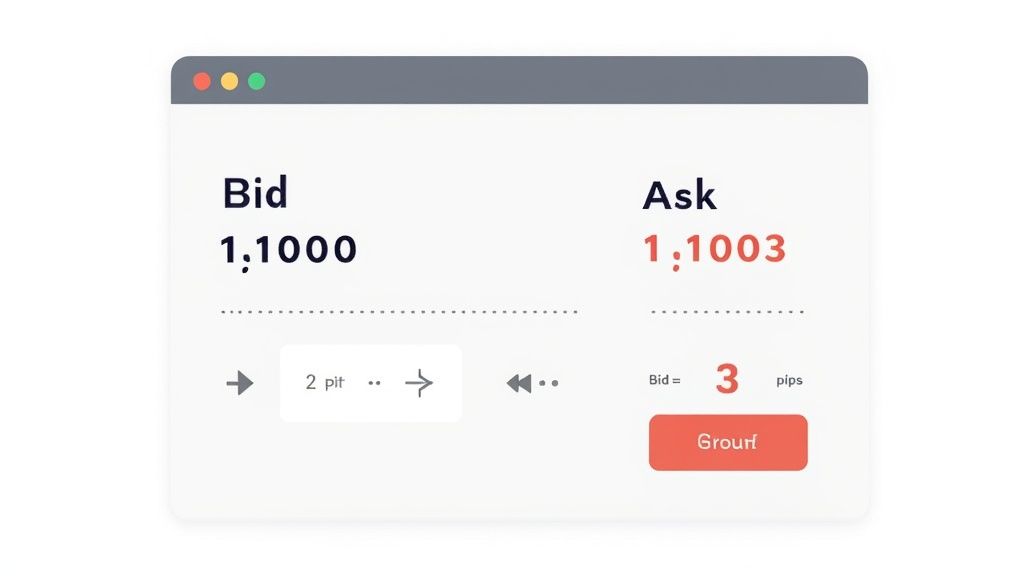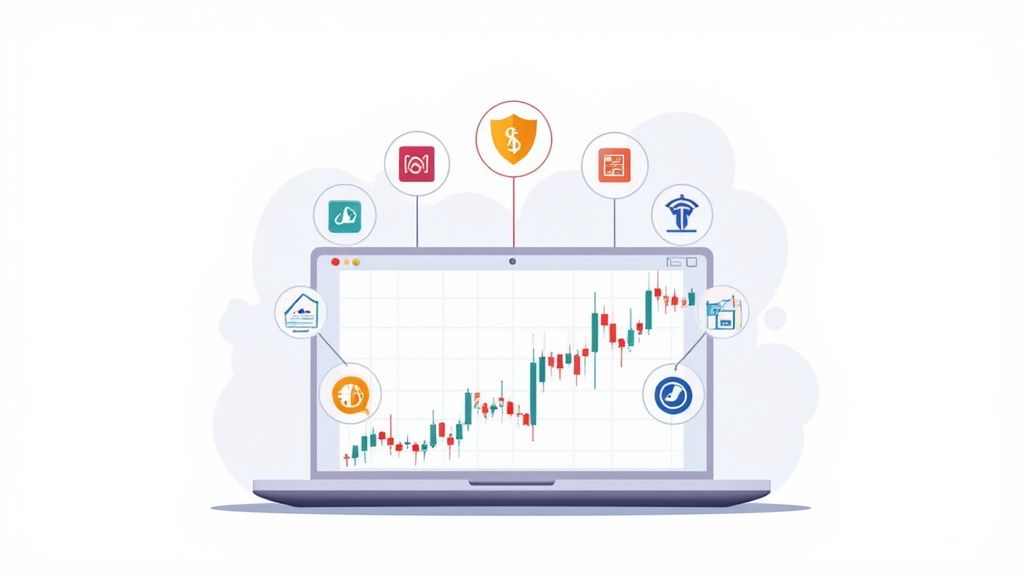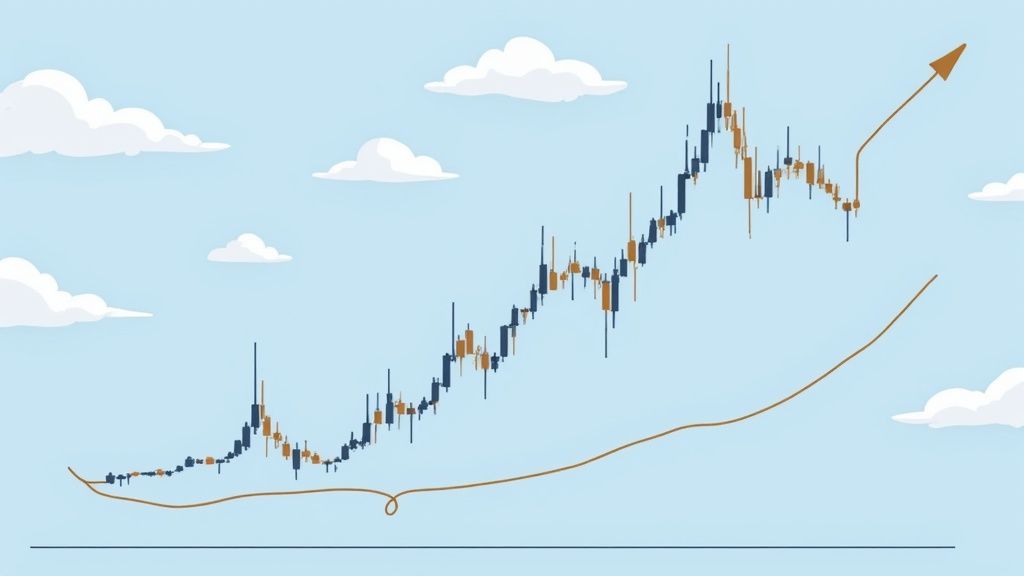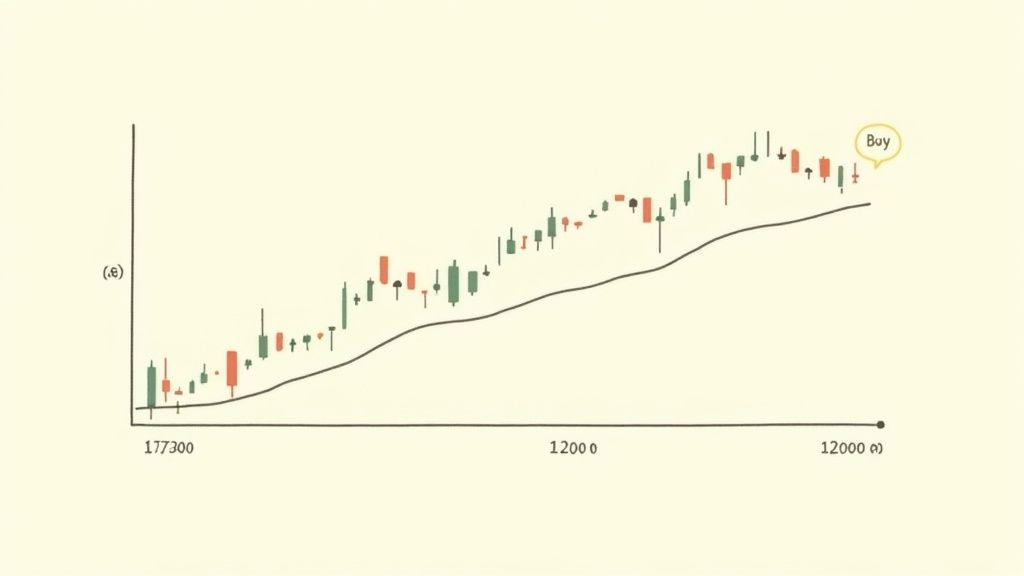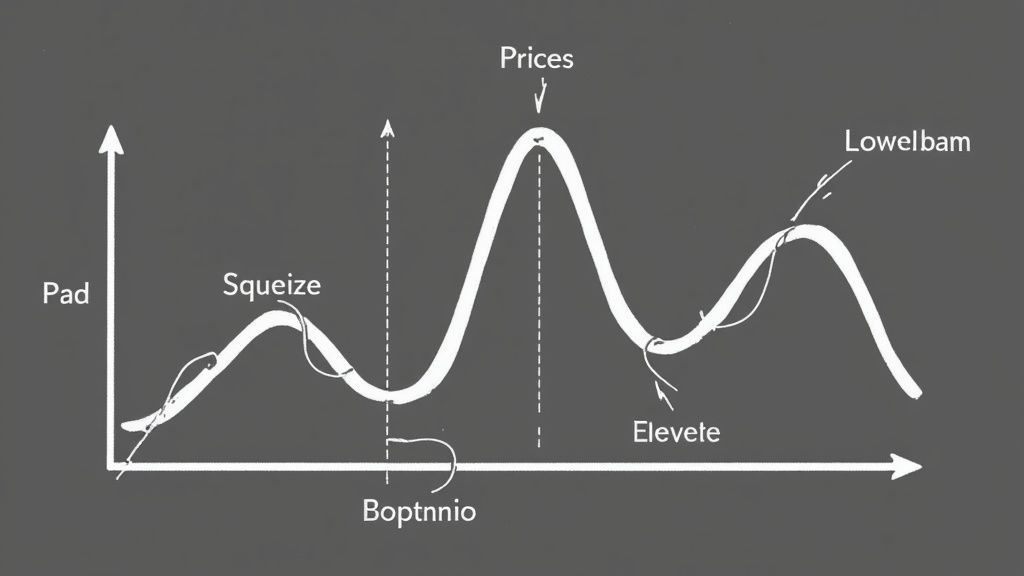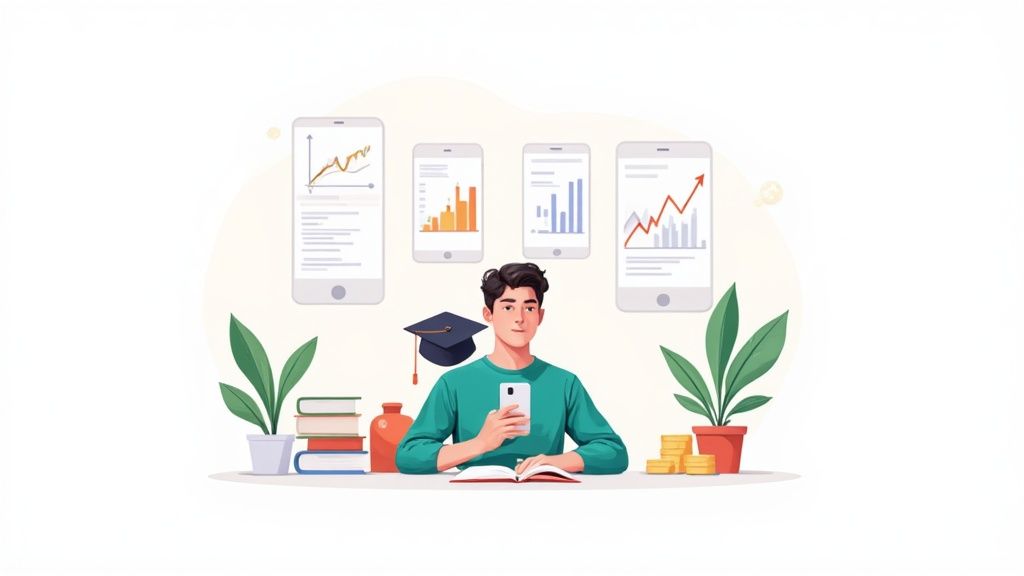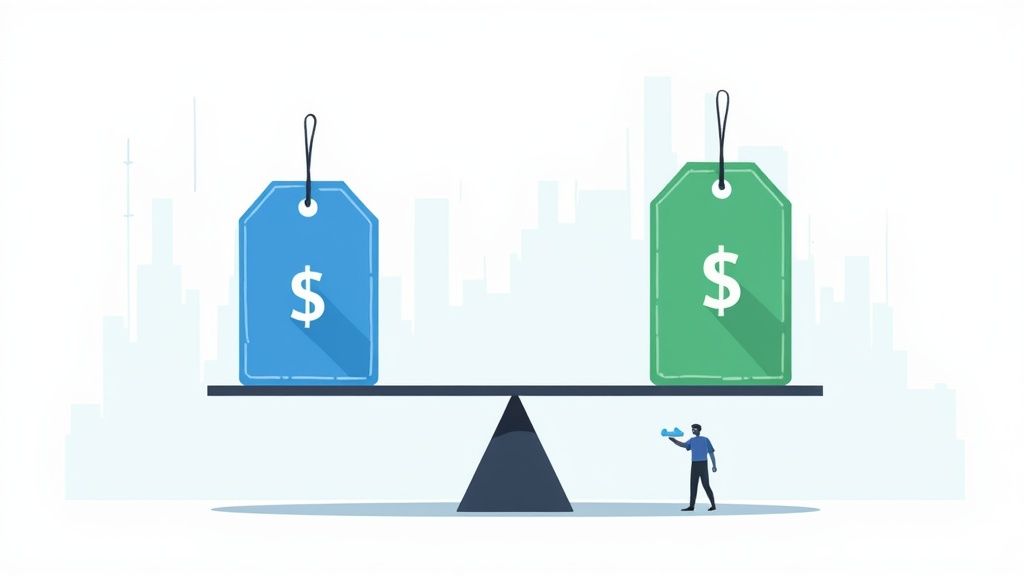ye
Ever feel like investing is a game only for Wall Street pros in suits? It's not. Thanks to some amazing apps, you can start building your future right from your phone, maybe even between classes. Think of it like this: if you can master a video game, you have the skills to learn how to invest.
Even Mark Cuban, the famous billionaire from 'Shark Tank,' said, "The best investment you can make is in yourself." Learning to invest is an investment in yourself. But where do you start? With so many platforms flashing promises of ‘zero fees’ and ‘easy trading,’ picking the right one can feel like the first big test.
Don't sweat it. We’re going to break down the best stock trading apps for beginners, talking straight about what's good, what's not, and which one fits your vibe. Before you dive in and pick an app, it’s a good idea to understand your personal comfort with risk; consider taking an investment risk tolerance quiz to help figure out your strategy. This guide gives you actionable insights- no confusing jargon- to go from zero to investor. We've included screenshots and direct links for each option, making your decision-making process simple and fast. Let's get this money.
1. Robinhood
Robinhood is famous for its simple, mobile-first design, making it one of the best stock trading apps for beginners. It stripped away the complexity found on older platforms, letting you buy and sell stocks, ETFs, and even some cryptocurrencies with just a few taps. The goal here is speed and simplicity, perfect for anyone who feels overwhelmed by traditional brokerage sites.
What Makes It Great for Beginners?
The app's biggest draw is how easy it is to get started. There are no account minimums, and you can trade U.S. stocks and ETFs completely commission-free. This means you can start with a small amount of money without worrying about fees eating into your investment.
A standout feature is fractional shares. Instead of needing hundreds of dollars to buy one share of a company like Apple, you can buy a small piece of it for as little as $1. This allows you to build a diverse portfolio even with a modest budget. A lesser-known fact: many celebrities, including Ashton Kutcher and Snoop Dogg, were early investors in Robinhood, drawn to its mission of making investing accessible to everyone.
Things to Keep in Mind
While its simplicity is a major pro, it's also a con. The platform lacks the deep research tools and advanced charting that more experienced traders rely on. It's built for straightforward buying and selling, not complex analysis. For beginners just starting their journey, however, Robinhood’s streamlined approach is often exactly what they need to get comfortable with investing.
Website: https://robinhood.com
2. Fidelity
Fidelity is a powerhouse in the investment world, but it has made huge strides to become one of the best stock trading apps for beginners. It combines the resources of a full-service brokerage with a user-friendly app, offering a platform that you can start with and grow into. This makes it ideal for anyone who wants a long-term home for their investments, not just a simple trading tool.
What Makes It Great for Beginners?
Fidelity offers $0 commission trades on U.S. stocks and ETFs, so you can invest without worrying about fees. A key feature is Fidelity Go, a robo-advisor service that helps build a portfolio for you, which is great if you're feeling unsure. They also offer fractional shares, which they call "Slices," letting you buy portions of expensive stocks for as little as $1.
The platform truly shines with its educational content. Fidelity provides an enormous library of articles, videos, and webinars to help you learn about investing. This focus on education makes it a fantastic starting point for anyone serious about building financial knowledge. Many beginners take a free online stock trading course to complement the resources Fidelity offers.
Things to Keep in Mind
Because Fidelity offers so much, the platform can feel a bit overwhelming at first compared to hyper-simplified apps. The sheer volume of tools and research might be more than a new investor needs. Also, it doesn't offer direct cryptocurrency trading, so you'll need another platform for that. However, for a reliable, all-in-one brokerage that supports your growth, Fidelity is tough to beat.
Website: https://www.fidelity.com
3. Charles Schwab (including thinkorswim)
Charles Schwab is a long-standing giant in the brokerage world, but its modern platform is surprisingly accessible, making it one of the best stock trading apps for beginners who want a service they can grow with. It combines robust features with excellent educational resources, offering a clear path from novice to confident investor. The platform provides commission-free stock and ETF trades, giving you a professional-grade experience without the professional-grade costs.
What Makes It Great for Beginners?
Schwab’s standout feature for newcomers is the thinkorswim platform and its paper trading simulator, paperMoney. This lets you practice trading with virtual money in a real-market environment, so you can learn the ropes and test strategies without risking a single dollar. It's like having a free, high-tech trading playground to build your skills.
The platform also offers 24/5 trading on many popular stocks and ETFs, giving you flexibility beyond standard market hours. With no account minimums and strong customer support, Schwab ensures you have the help you need, whenever you need it. The combination of powerful tools and risk-free practice is perfect for anyone serious about learning to invest properly.
Things to Keep in Mind
The sheer number of features on the thinkorswim platform can feel overwhelming at first. Unlike simpler apps, Schwab is packed with advanced charting tools, screeners, and data, which can present a steep learning curve. However, for a beginner willing to put in a little time, mastering this platform means you'll have a powerful toolset that you won't outgrow as your skills advance.
Website: https://www.schwab.com
4. E*TRADE from Morgan Stanley
E*TRADE offers a powerful platform that grows with you, making it one of the best stock trading apps for beginners who plan to become more advanced traders. It strikes a great balance between user-friendly design for newcomers and sophisticated tools for those who want to dig deeper. Backed by Morgan Stanley, it provides a sense of security and access to high-quality research from the start.
What Makes It Great for Beginners?
The platform uniquely offers two mobile apps: the standard ETRADE Mobile app, which is perfect for everyday investing, and the Power ETRADE app, which is loaded with advanced charting and analysis tools. This two-app system lets you start simple and then "graduate" to the more complex app without ever having to switch brokerages.
Like its competitors, E*TRADE offers $0 commission trades on U.S. stocks and ETFs. It also provides access to a huge range of investment products, including mutual funds, bonds, and futures, which is great for expanding your portfolio down the line. The integration of Morgan Stanley research gives you professional insights you might not find on other beginner-focused apps.
Things to Keep in Mind
While E*TRADE is a fantastic all-around platform, its options trading fees aren't the absolute lowest unless you're a very active trader. The sheer amount of features and data available, even on the basic app, might feel slightly more complex than a hyper-streamlined app like Robinhood. However, for a beginner who is serious about learning and growing, this comprehensive environment is a major advantage.
Website: https://us.etrade.com
5. Webull
Webull is often seen as the next step up from simpler apps, offering a powerful suite of tools that appeal to beginners who want to grow into more advanced trading. It combines a sleek, modern interface with features typically found on professional platforms, making it one of the best stock trading apps for beginners who are serious about learning the ropes. You can trade stocks, ETFs, and options commission-free.
What Makes It Great for Beginners?
Webull’s standout feature for newcomers is its free paper trading simulator. This lets you practice trading with virtual money in a real-market environment, so you can build confidence and test strategies without risking a single dollar. It’s like a video game for investing where you can learn from mistakes for free.
Additionally, Webull offers fractional shares, so you can invest in pricey stocks with as little as $5. It also provides extended-hours trading, advanced charts, and a comprehensive education center right in the app. For those interested in options, Webull charges no per-contract fees, a significant cost-saving benefit.
Things to Keep in Mind
The abundance of tools can feel a bit overwhelming at first compared to ultra-simple apps. There's a slight learning curve to navigate all the charts and technical indicators available. However, for a beginner who is eager to learn and wants access to powerful analytical tools from day one, Webull provides an incredible platform to grow with.
Website: https://www.webull.com
6. SoFi Invest
SoFi Invest positions itself as an all-in-one financial hub, making it one of the best stock trading apps for beginners who want to manage their money and investments in a single place. The platform offers a clean, approachable way to start trading U.S. stocks and ETFs without getting bogged down by complicated tools. Its design encourages you to build good financial habits from the start.
What Makes It Great for Beginners?
SoFi Invest excels by integrating investing with your other financial accounts, like banking and loans. You can trade stocks and ETFs with $0 commissions and no account minimums. A key feature is Stock Bits, their version of fractional shares, letting you buy pieces of big-name stocks for as little as $5. This makes diversification accessible on any budget.
For those who want a hands-off approach, SoFi offers automated investing portfolios with a low advisory fee. It also provides a unique opportunity for beginners to participate in Initial Public Offerings (IPOs) when available, a feature typically reserved for wealthier investors. The platform is packed with educational content to help you learn as you go.
Things to Keep in Mind
The biggest strength of SoFi-its all-in-one nature-can also be a limitation. It lacks the advanced charting software, in-depth research reports, and complex order types that dedicated day traders would need. It’s built for long-term, straightforward investing rather than high-frequency trading. For newcomers, however, this simplified focus helps keep investing from feeling intimidating.
Website: https://www.sofi.com/invest/
7. Public
Public combines investing with a social community, making it a unique choice among the best stock trading apps for beginners. It allows you to follow other investors, see what they're buying and selling, and share your own trade ideas. This social layer helps demystify investing by showing you that you're not alone in your journey, creating a collaborative learning environment.
What Makes It Great for Beginners?
Public offers commission-free trading on U.S. stocks and ETFs with no account minimums, making it highly accessible. A key differentiator is its commitment to transparency. Unlike many competitors, Public does not participate in Payment for Order Flow (PFOF) for standard stock trades, meaning your orders are routed to find the best possible price, not to make the broker money.
For those just starting, fractional shares let you invest in big-name companies with as little as $1. Public also provides access to alternative investments like Treasury bills, which offer a stable, low-risk way to earn yield on your cash. The community feed and educational content are integrated directly into the app, helping you learn as you go.
Things to Keep in Mind
While the social aspect is great for learning, it can also encourage herd mentality, so it's important to do your own research. The platform's product selection is also more limited than that of a traditional, full-service brokerage. However, for a beginner focused on building foundational knowledge within a supportive community, Public offers a transparent and engaging entry point into the world of investing.
Website: https://public.com
8. M1
M1 offers a unique twist on investing, blending the control of a brokerage with the automation of a robo-advisor. Instead of focusing on day-to-day trades, it encourages you to build custom portfolios, or "Pies," and then automates the process of funding and balancing them. This "set it and forget it" approach makes it one of the best stock trading apps for beginners who want a structured, long-term strategy.
What Makes It Great for Beginners?
The platform's main appeal is its automated, rules-based system. You create a Pie by selecting stocks and ETFs and assigning a target percentage for each. When you deposit money, M1 automatically buys shares to match your targets, including fractional shares, to keep your portfolio perfectly balanced. This removes the guesswork and emotion from investing.
You can set up recurring deposits and let the platform handle the rest, making it incredibly low-effort. This hands-off method is perfect for anyone who wants to build a diversified portfolio without the stress of timing the market or manually rebalancing their holdings. It’s a powerful tool for developing disciplined investing habits from day one.
Things to Keep in Mind
M1 is not designed for active traders. It has one or two scheduled "trade windows" per day, meaning you can't buy or sell stocks instantly throughout the day. This reinforces its long-term focus but can be a drawback for those who want to react to market news immediately. Also, there is a $3 monthly platform fee unless you maintain an account balance over $10,000 or have an active M1 Personal Loan.
Website: https://www.m1.com
9. Merrill Edge Self-Directed (Bank of America)
For those who already bank with Bank of America, Merrill Edge Self-Directed is a natural and powerful choice. It seamlessly integrates your banking and investing into a single, cohesive experience. The platform offers a stable and reputable environment, perfect for beginners who value the security of a well-established financial institution while exploring the world of stock trading.
What Makes It Great for Beginners?
The biggest advantage is the integration. You can instantly transfer money between your Bank of America checking account and your Merrill Edge investment account, making funding your trades incredibly easy. Like other modern brokers, it offers $0 commission on online stock and ETF trades, which is essential for new investors.
The real magic happens with the Preferred Rewards program. Based on your combined BofA and Merrill balances, you can earn discounts, get credit card bonuses, and receive other banking perks. This synergy turns your investing activity into a benefit across all your finances, creating a rewarding all-in-one system. For more information, you can dive into comparing brokerage fees to see how it stacks up.
Things to Keep in Mind
While the platform provides access to high-quality Bank of America research, it’s not built for hyperactive day traders. The interface is more traditional and less gamified than some of the newer apps on this list. Additionally, its options trading fee of $0.65 per contract isn't the lowest available. However, for a beginner looking for a reliable, integrated, and feature-rich platform from a trusted name, Merrill Edge is an outstanding option.
Website: https://www.merrilledge.com
10. Vanguard Brokerage
Vanguard is a giant in the investing world, and it's built its reputation on a simple, powerful idea: long-term, low-cost investing. While it might not have the flashy interface of newer apps, it’s one of the best stock trading apps for beginners who want to build wealth slowly and steadily without distractions. It’s perfect for the "set it and forget it" type of investor.
What Makes It Great for Beginners?
Vanguard shines for its focus on low-cost index funds and ETFs. These funds let you own a small piece of the entire market, which is a fantastic strategy for diversification. The platform offers $0 commission on online stock and ETF trades, so you can invest without worrying about fees chipping away at your returns.
The app's design is straightforward, guiding you toward a buy-and-hold strategy rather than encouraging risky, frequent trading. Vanguard is famous for its extremely low expense ratios on its own funds, meaning more of your money stays invested and working for you over the long run. As the legendary investor Warren Buffett said, "Costs really matter in investments. If returns are going to be 7 or 8 percent and you're paying 1 percent for fees, that makes an enormous difference in how much money you're going to have in retirement."
Things to Keep in Mind
This platform is not designed for active, day-to-day traders. The research tools are basic compared to competitors, and the interface lacks the advanced charting features that short-term traders need. Additionally, its options trading fees are higher than many other brokerages, at around $1 per contract. Vanguard is built for one thing- long-term wealth creation- and it does that exceptionally well.
Website: https://investor.vanguard.com
11. Cash App Investing
If you already use Cash App to send and receive money, its investing feature is one of the easiest ways to start trading. Designed for absolute simplicity, it lets you buy and sell stocks and ETFs directly within the app you know. This integration makes it a top contender among the best stock trading apps for beginners who want to dip their toes into investing without signing up for a complex new service.
What Makes It Great for Beginners?
The platform's main appeal is its extreme accessibility. You can start investing with just $1, thanks to fractional shares, and there are no commissions on stock and ETF trades. This removes nearly all barriers for someone with a small budget.
Cash App Investing also offers unique features tied to its ecosystem. You can set up an Auto-Invest plan to buy stocks on a recurring schedule or use Round Ups to automatically invest spare change from your Cash Card purchases. It’s a seamless way to build a portfolio without even thinking about it.
Things to Keep in Mind
Cash App Investing is built for convenience, not for in-depth analysis. The platform has very limited research tools, charts, and educational resources compared to dedicated brokerage apps. It's perfect for straightforward buying and holding, but if you want to learn detailed market analysis or access a wider range of investment products, you’ll likely outgrow it quickly.
Website: https://cash.app/stocks
12. NerdWallet’s Best Stock/Investment Apps (Comparison Hub)
Instead of being a trading app itself, NerdWallet’s comparison hub is an essential research tool. It’s a continuously updated guide that evaluates and ranks many of the best stock trading apps for beginners. It simplifies the overwhelming process of choosing a platform by presenting key information, like fees and features, in one easy-to-scan place.
What Makes It Great for Beginners?
The biggest benefit is saving time and avoiding confusion. Instead of visiting a dozen different brokerage websites, you get a neutral, aggregated overview. The platform provides filters that let you sort apps based on your specific priorities, such as finding one with practice trading accounts, low fees, or strong educational resources.
A standout feature is the up-to-date ratings and fee summaries. Financial platforms change their fee structures often, and NerdWallet does the hard work of keeping track. This helps you quickly match with a broker that fits your budget and investment goals, providing direct links to open an account once you’ve made your choice.
Things to Keep in Mind
Since NerdWallet is an aggregator, it's a starting point, not the final word. You should always click through to the broker’s official site to verify the most current details before signing up. Also, be aware that the lists may include partner or affiliate links, which is how the site makes money, but they are clearly disclosed.
Website: https://www.nerdwallet.com/best/investing/stock-apps
Top 12 Stock Trading Apps: Feature & Fee Comparison
| Platform |
Core Features & Tools |
User Experience & Quality ★★★★☆ |
Value Proposition 💰 |
Target Audience 👥 |
Unique Selling Points ✨ |
Price Points 💰 |
| Robinhood |
Commission-free stocks/ETFs, fractional shares, equity options, IRA Match |
Simple onboarding, mobile & desktop UX |
Low cost, retirement IRA Match |
Beginner investors 👥 |
IRA Match 🏆, easy interface |
$0 commissions, $0 options fees |
| Fidelity |
$0 stock/ETF trades, fractional 'Slices', deep research |
Comprehensive tools, strong education |
Extensive research & support |
Beginners to advanced traders 👥 |
Broad account types, strong customer support |
$0 stock/ETF, some pro complexity |
| Charles Schwab (thinkorswim) |
$0 stocks/ETFs, options $0.65 per contract, paperMoney simulator |
Powerful but complex platforms |
Versatile platforms for all levels |
Beginners & advanced 👥 |
Paper trading simulator, 24/5 trading |
$0 stocks/ETFs, $0.65 options |
| E-TRADE (Morgan Stanley) |
Two apps, $0 stock/ETF trades, options with discounts, futures |
Smooth beginner→advanced transition |
Comprehensive product menu |
Beginner to active traders 👥 |
Integrated Morgan Stanley research |
$0 stocks/ETFs, $0.65–$0.50 options |
| Webull |
Paper trading, advanced charts, fractional shares, $0 options fees |
Feature-rich but learning curve |
Free practice tools for hands-on learning |
Beginners wanting practice 👥 |
No per-contract option fees, extended hrs |
$0 commissions, $0 option fees |
| SoFi Invest |
$0 commissions, fractional 'Stock Bits', automated portfolios |
Very approachable, simple app |
All-in-one banking & investing |
First-time investors 👥 |
IPO access, integrated education |
$0 stocks/ETFs, 0.25% advisory fee |
| Public |
$0 commissions, fractional shares, Treasury accounts, community feed |
Transparent execution, community-driven |
Execution transparency & fixed income choices |
Cautious beginners & community 👥 |
No PFOF on regular hours, unique community feed |
$0 commissions |
| M1 |
Automated investing, fractional shares, scheduled trades |
Low-effort, set-and-forget investing |
Automation & diversification |
Beginners wanting automation 👥 |
Customizable 'Pies', recurring deposits |
$3/month fee unless $10k+ assets |
| Merrill Edge (Bank of America) |
$0 stock/ETF trades, $0.65 options, BofA integration |
Stable platform, strong banking link |
Rewards for BofA customers |
BofA customers 👥 |
Preferred Rewards program, instant transfers |
$0 stocks/ETFs, $0.65 options |
| Vanguard Brokerage |
$0 stock/ETF trades, low-cost funds, simple platform |
Clear, minimal distractions |
Low fund expenses, buy-and-hold focus |
Long-term investors 👥 |
Emphasis on low-cost index funds |
$0 stocks/ETFs, ~$1 options |
| Cash App Investing |
$0 stock/ETF commissions, $1 fractional shares, auto-invest |
Extremely simple, integrated with Cash App |
Very low barrier to entry |
Absolute beginners 👥 |
$1 fractional shares, Cash App ecosystem |
$0 commissions |
| NerdWallet Comparison Hub |
Ratings, filters by user priorities, direct broker links |
Neutral, up-to-date overview |
Saves time matching needs |
All user levels 👥 |
Continuously updated, broad overview |
Free to use |
Your Next Move: From Learning to Earning
Whew, that was a deep dive! But now you have a detailed roadmap to the world of investing. The perfect app for you is definitely on this list – it just depends on your personal goals and what kind of investor you want to become.
Think of it this way: choosing an app is like picking your first car. Do you want something super simple and straightforward to get you from A to B, like Cash App Investing? Or are you the type who wants to look under the hood, learn the mechanics, and maybe even race one day? If that’s you, then practicing with a "paper trading" account on a more powerful platform like Webull or Charles Schwab's thinkorswim is the perfect first step. It’s like a realistic driving simulator for the stock market.
How to Choose Your Perfect Match
To find the best stock trading apps for beginners that fit your life, ask yourself a few simple questions:
- What's my main goal? Am I trying to build long-term wealth slowly and steadily (like with Vanguard or Fidelity)? Or am I more interested in learning the ropes of active trading (like with Webull)?
- How much help do I need? Do I want an app with a huge library of educational articles and videos, like E*TRADE or Fidelity? Or do I prefer learning from other people in a social setting, like on Public or SoFi Invest?
- Where do I already bank? If you’re already a Bank of America customer, using Merrill Edge can make moving money around super easy and might even get you extra perks.
The most important takeaway is that getting started is more important than being perfect. As the great hockey player Wayne Gretzky famously said, "You miss 100% of the shots you don't take." Your journey starts with picking one of these tools, diving into the educational resources they offer, and being patient as you learn. That’s where the real power is.
Your Action Plan for Getting Started
Don't just let this information sit here. Take action! Here’s a simple plan:
- Pick Two or Three Apps: Based on your answers above, narrow down the list to your top contenders.
- Explore Their Websites: Spend 10-15 minutes on each site. Check out their educational content and get a feel for the platform.
- Download and Try One: Choose your favorite and open an account. You don't have to fund it with a lot of money right away. Start small, maybe with just enough to buy a single share of a company you believe in.
As you gain experience and start looking for advanced features, you might want to explore top real-time stock alert apps that can help you stay on top of market movements. But for now, focus on mastering the basics. Your investing journey officially starts now. Pick your app, make a plan, and begin building your future, one smart decision at a time.
Feeling a little overwhelmed and want to build your confidence before you invest your first dollar? At financeillustrated.com, we turn complex financial topics into simple, beautiful visuals you can understand in minutes. Check out financeillustrated.com to learn the fundamentals of investing through engaging graphics and guides designed for beginners.


